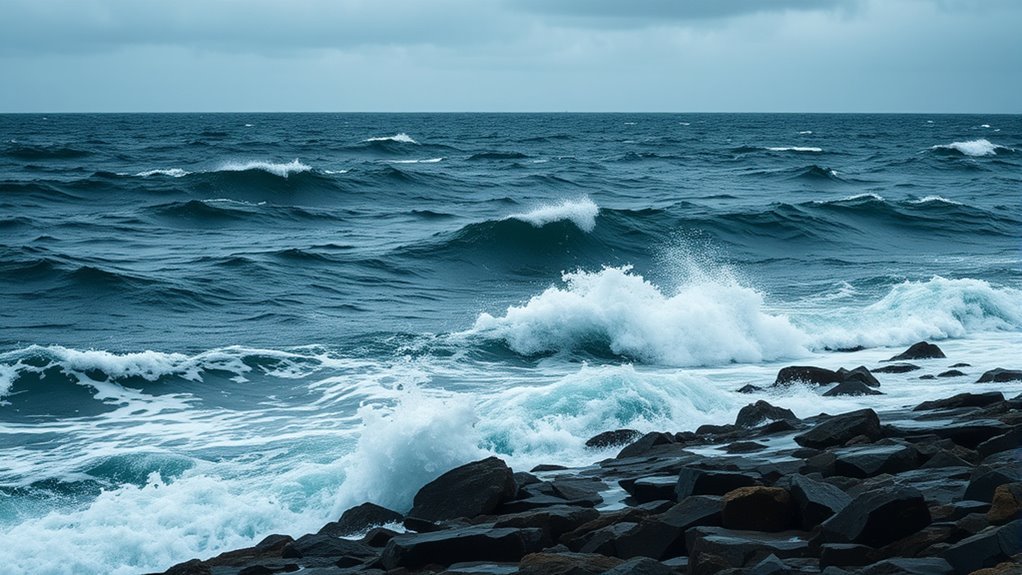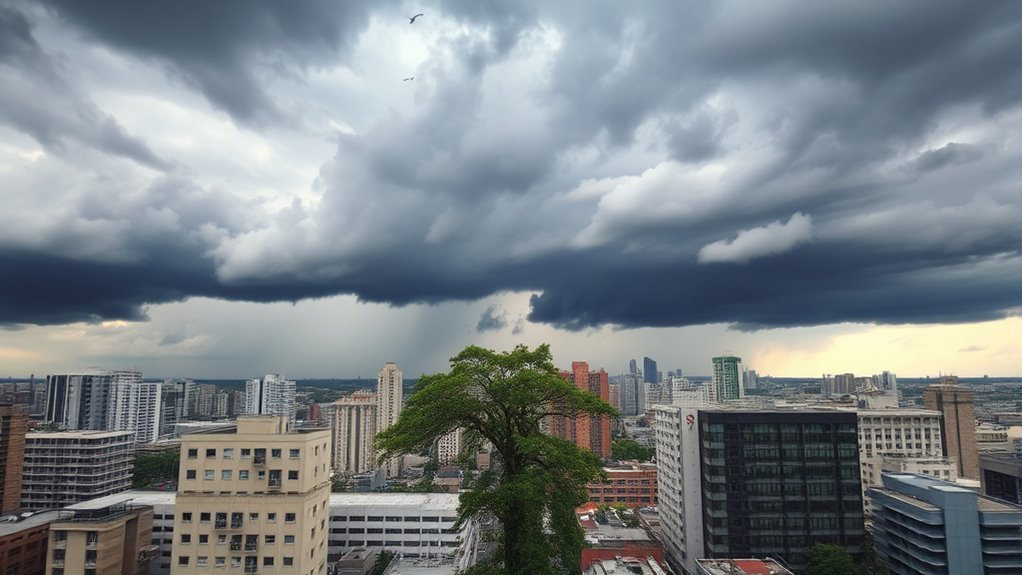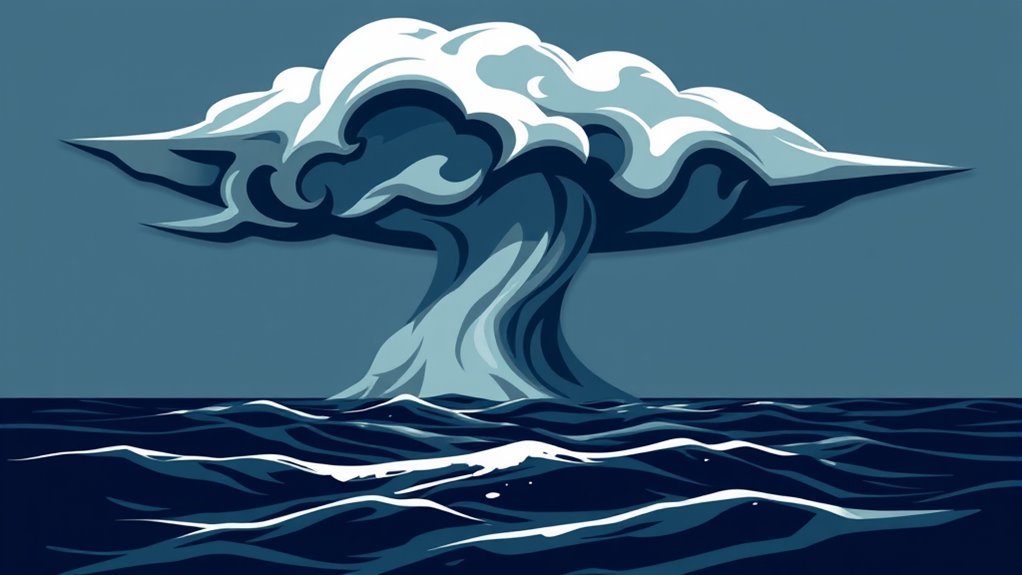Changing weather patterns, primarily driven by climate change, lead to increased temperature variability, which greatly affects squall frequency and intensity. Warmer air holds more moisture, creating more unstable atmospheric conditions conducive to squalls. Additionally, altered ocean currents and urbanization contribute to localized warming, further enhancing squall activity. These factors make squalls more unpredictable and challenging to forecast. Exploring these dynamics reveals more about their consequences for weather patterns and safety measures.
Main Points
- Climate change increases temperature variability, disrupting atmospheric circulation patterns that lead to more frequent squall formation.
- Warmer air can hold more moisture, enhancing atmospheric instability and contributing to the development of squalls.
- Increased surface temperature gradients boost wind shear, which is critical for organizing squall systems.
- Warm ocean currents create conditions for instability by meeting cooler air masses, thus fostering squall activity.
- Urbanization contributes to localized warming and altered microclimates, increasing the intensity and frequency of squalls in urban areas.
Understanding Squalls: Definition and Characteristics
Squalls are sudden, sharp increases in wind speed, often accompanied by rain or other precipitation. These meteorological phenomena can occur in various settings, including maritime environments and land areas.
Typically, a squall lasts for a brief duration, usually less than an hour, but it can produce intense weather conditions. The winds may reach speeds exceeding 30 knots, creating hazardous situations for sailors and outdoor enthusiasts. Squalls may be associated with thunderstorms or cold fronts, where a rapid change in atmospheric pressure triggers the sudden gusts.
The characteristics of squalls include their unpredictability and localized nature, often making them challenging to forecast accurately. The abrupt shift from calm to turbulent conditions can result in strong, turbulent air, leading to notable disruptions.
Squalls are essential to understand, as they can impact aviation, boating, and recreational activities, necessitating awareness and preparedness in vulnerable areas.
The Role of Climate Change in Weather Patterns

Climate change considerably impacts weather patterns, leading to increased temperature variability across different regions.
This variability can disrupt traditional atmospheric circulation patterns, ultimately influencing the formation and intensity of squalls.
Understanding these changes is essential for predicting future weather events and their potential consequences.
Increased Temperature Variability
As temperatures fluctuate more dramatically due to climate change, weather patterns become increasingly erratic, contributing to the formation and intensity of squalls.
This variability affects not only daily weather but also the long-term climate system, which can lead to unpredictable squall events. Regions that previously experienced stable temperatures may now encounter sudden shifts, resulting in the rapid development of atmospheric disturbances.
Increased temperature variability can cause more frequent interactions between warm and cold air masses, cultivating conditions ripe for squall formation.
Consequently, the unpredictability of these weather events poses challenges for forecasting and preparedness, impacting both natural ecosystems and human activities.
Understanding this relationship between temperature variability and squalls is essential for developing flexible strategies in an evolving climate.
Altered Atmospheric Circulation Patterns
Changes in temperature variability are closely linked to alterations in atmospheric circulation patterns, which greatly influence weather dynamics.
As climate change progresses, shifts in jet streams and ocean currents disrupt established weather systems, leading to more frequent and intense squalls. These altered circulation patterns can improve moisture transport, resulting in sudden precipitation events.
Additionally, changes in wind patterns can affect the stability of air masses, contributing to the development of severe weather phenomena. The interaction between warm and cold air masses is vital for squall formation; therefore, any disturbance in atmospheric circulation can increase their occurrence.
Understanding these changes is essential for predicting future weather events and mitigating their potential impacts on communities.
How Temperature Increases Affect Squall Formation
Increasing temperatures greatly impact the dynamics of squall formation, as warmer air can hold more moisture, leading to improved instability in the atmosphere. This increase in atmospheric moisture contributes to the development of convective systems, which are essential for squall formation.
As the air temperature rises, the likelihood of rapid upward movement of warm, moist air also increases, creating conditions conducive to intense thunderstorm activity.
Moreover, higher temperatures can cause a more pronounced temperature gradient between the surface and the upper atmosphere. This gradient can boost wind shear, a critical factor in the organization of squall lines.
Additionally, increased heat can lead to more frequent and intense weather phenomena, such as heat waves, which can further destabilize the atmospheric conditions necessary for squalls.
Consequently, rising temperatures are directly linked to a greater frequency and intensity of squall events, underscoring the importance of monitoring temperature trends in weather forecasting.
The Influence of Ocean Currents on Squall Activity

Ocean currents play an important role in influencing squall activity by affecting both temperature and moisture distribution across regions. These currents transport warmer water from equatorial regions towards the poles, which can raise sea surface temperatures. Higher temperatures lead to increased evaporation, resulting in higher humidity levels in the atmosphere. This added moisture is critical for the development of squalls, as it boosts convection processes that can trigger sudden storms.
Additionally, ocean currents can modify wind patterns, additionally influencing squall dynamics. For instance, when warm ocean currents meet cooler air masses, it creates instability, often resulting in squall formation.
Moreover, the interaction between ocean currents and atmospheric systems can lead to the reinforcement of squalls, increasing their frequency and intensity in certain areas.
The Impact of Urbanization on Local Weather Dynamics

Although urbanization often denotes progress and development, it greatly alters local weather dynamics in various ways. The proliferation of buildings, roads, and other infrastructure creates urban heat islands, where temperatures are notably higher than surrounding rural areas. This localized warming can improve convection currents, potentially leading to increased precipitation and storm intensity.
Additionally, the alteration of natural terrains disrupts local airflow patterns, which can affect humidity levels and cloud formation. Urban surfaces, such as concrete and asphalt, absorb and retain heat, contributing to altered microclimates.
Moreover, increased air pollution from vehicles and industrial activities can lead to the formation of smog, which impacts sunlight penetration and can modify local weather conditions. As urban areas continue to expand, understanding these changes becomes critical for predicting weather-related phenomena, including squalls, thereby highlighting the complex relationship between urbanization and local weather dynamics.
Predicting Squalls: Tools and Techniques
As meteorologists seek to understand and predict squalls, they employ a variety of tools and techniques that improve forecasting accuracy.
Advanced radar systems play a significant role, allowing meteorologists to detect precipitation and monitor storm development in real time. Satellite imagery provides critical information about cloud patterns and atmospheric conditions, enabling forecasters to identify potential squall formation areas.
Numerical weather prediction models simulate atmospheric processes, offering forecasts based on current weather data and historical patterns. Additionally, weather buoys and surface stations collect data on temperature, humidity, and wind speed, which are fundamental for understanding local dynamics.
Machine learning algorithms are increasingly being integrated into forecasting, analyzing extensive datasets to identify trends and improve prediction outcomes.
Preparing for Squalls: Mitigation Strategies and Safety Measures
While squalls can develop rapidly and pose considerable threats to safety, effective preparation and mitigation strategies can help minimize their impact. Individuals living in areas prone to squalls should stay informed about weather forecasts and alerts, enabling timely responses to developing conditions.
Creating a safety plan that includes designated shelter locations and emergency contact information is essential. In addition, securing outdoor items that could become projectiles during high winds can reduce property damage. Emergency kits stocked with essentials such as water, non-perishable food, flashlights, and first aid supplies should be accessible.
Communities can improve resilience by investing in infrastructure improvements, such as proper drainage systems, to mitigate flooding risks associated with heavy rainfall. Public awareness campaigns can also educate residents on recognizing squall signs and the importance of swift action, eventually encouraging a culture of preparedness and safety in vulnerable regions.
Common Questions
How Do Squalls Differ From Thunderstorms?
Squalls are brief, intense windstorms often accompanied by rain, while thunderstorms involve lightning, thunder, and precipitation. Squalls typically occur over water or land, whereas thunderstorms are associated with larger storm systems and unstable atmospheric conditions.
What Regions Are Most Affected by Squalls?
Regions most affected by squalls include coastal areas, especially in tropical and subtropical climates. These regions experience sudden weather changes due to warm ocean waters, leading to frequent and intense squall events throughout the year.
Can Squalls Occur in Winter Months?
Squalls can indeed occur during winter months, particularly in coastal regions and areas experiencing abrupt temperature changes. These sudden weather events often bring strong winds and intense precipitation, impacting local conditions despite the season.
Are Squalls More Common at Night or During the Day?
Squalls can occur both day and night, but research indicates they are often more common during the day. Daytime heating can improve instability, leading to conditions favorable for the development of squall lines.
How Long Do Squalls Typically Last?
Squalls typically last between a few minutes to half an hour. Their duration can vary considerably due to atmospheric conditions, but they are commonly brief yet intense, bringing sudden changes in wind and precipitation.

